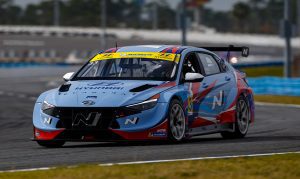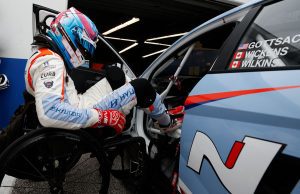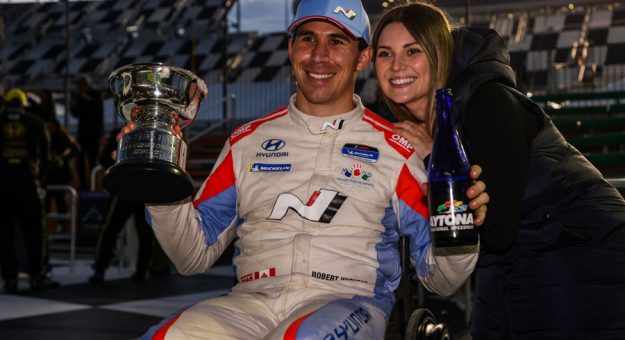Three years after a frightening NTT IndyCar Series crash at Pennsylvania’s Pocono Raceway, Robert Wickens returned to racing.
Wickens became a paraplegic when his car slammed the wall at the 2.5-mile track, derailing a stellar driving career that was heading for a low-earth orbit.
The 33-year-old Canadian scoffed at the doctor’s prognosis that he would never walk again and vowed to dance at his 2019 wedding. He exchanged vows and kept his promise to his now wife, Karli, dancing at their wedding in a video that went viral on the internet.
The thought of leaving racing never entered Wickens’ mind, and he was determined to find a way to drive again.
Wickens began his career in Europe, racking up victories in many different series. It began in Formula BMW at age 16. He scored five podium finishes, including two wins and an appearance in the BMW World Final.
He moved to the Formula Renault 3.5 series, GP3 competition and back to Formula Renault, winning the championship in 2011. Wickens continued to branch out with drives in DTM, Formula 2 and an “off the record” Formula 1 test.
Returning to North America, Wickens found a new home in the IndyCar series.
In June 2017, he joined Schmidt Peterson Motorsports. His first start was at the scenic Road America circuit, subbing for Mikhail Aleshin who had immigration issues after competing at the 24 Hours of Le Mans.
Wickens proved himself and earned a full-time ride with the team in 2018. He earned rookie-of-the-year honors during that year’s Indianapolis 500.

Several more competitive runs followed. Railbirds believed a victory would come soon, but Wickens’ luck broke bad when the series visited Pocono in August 2018. Despite suffering a myriad of injuries, it quickly became apparent nothing was going to stop Robert Wickens.
“I didn’t think it would end my career, but it was going to be a setback,” Wickens recalled. “There were so many inspirational people like Alex Zanardi and people similar to him that I knew returning from a near-death experience was always a possibility.”
And there’s more: “That being said, every injury is different and has their own complications. I always knew it was possible and finding the right people that believed in me could make it happen.”
In a stroke of serendipity, Bryan Herta called and offered a test in Michael Johnson’s car at Mid-Ohio Sports Car Course. The wheelchair-bound Johnson had moved to Herta’s team after several years with JDC Motorsports.
Wickens’ road back to racing has been nothing short of remarkable.
“So far so good; I never lost self-confidence that I could do it. It was just a matter of finding someone that believed in me,” Wickens said. “Bryan Herta and his partners at Bryan Herta Autosport, with the help of Hyundai put their faith in me and the rest is history. Michael Johnson has been the pioneer of racing. When I had the opportunity to test his car Mid-Ohio in May of last year, it really kicked in the whole dream that he had a hand-controlled car and was willing to share it with me was the big push that got me started.”
Johnson, who was an aspiring motorcycle racer when he was paralyzed in 2005 at age 12, brought the hand- control system he used at JDC Motorsports to Bryan Herta’s engineers and they tweaked the design.
“The improvements we’ve made since the first year and now in 2022 have been unbelievable. They’ve been really, really good,” Johnson explained. “The changes we’ve made are shrinking down the setup, working with the existing steering wheel that comes with the Hyundai Elantra TCR car. We’ve designed a new brake ring that is on the back side of the steering wheel.
“Also, on the back side of the steering wheel on the bottom is the throttle. There’s a paddle on the left side and a paddle on the right side depending on what hand I want to use. That’s been really, really good — refining the brake and throttle has made it a lot easier when I’m on track. It’s improved my driving and my lap times as well.”
Wickens quickly adapted to the system and had some ideas of his own to improve the unit.
“It’s unique because Michael only knows motorsports as a paralyzed man where with me, I spent the majority of my career using my feet and know what a proper brake pedal should feel like,” Wickens explained. “When I knew I would have to drive using hand controls, I wanted to replicate the same sensations but using my hands instead of my feet.

“The system Michael had was a great system but it wasn’t optimized. Michael just learned how to use it through repetition, but there were definitely some opportunities to allow the driver to have a lot more feeling in the cockpit with the steering wheel and that’s what we worked on,” Wickens added. “We did that by relocating the throttle. Now, it’s on the back of the steering wheel where the clutch would be in a Formula 1 or Indy car. The brake system is exactly the same as it was, same location. We relocated the shift paddles to the original positioning (for semi-automatic cars).
“So when the able-bodied driver gets in on a driver change, nothing is different for them,” Wickens continued. “That was one issue Michael Johnson and Steven Simpson had before because he would have to adapt to a new shift system and the other controls were a little bit different.
“This way with the Hyundai Elantra when the able-bodied driver is driving, it is like he’s driving a standard car. He doesn’t have to adapt to any differences. I think that’s important because you can’t change it too much because you’re affecting your teammate as well. The Hyundai system is different than the BMW because they don’t change steering wheels.”
Herta has made other adjustments to help Wickens and Johnson.
“It gives us an opportunity to grow and look at ways we can get better. Things like traveling are different for the drivers and they manage all of that stuff on their own,” Herta said. “Accessibility at the track out of our trucks (is another consideration). The engineering offices in the trucks are at the front of the hauler and aren’t set up for accessibility, so it means putting in ramps and creating environments so they’re accessible for all team members. Those are the logistical things we’ve had to learn.”
The season has had its hiccups but shows a lot of promise for better results. A pit-stop problem ended a win or podium finish. Still, Wickens finished on the podium in his first race at Daytona in February. Herta is a patient man and sees the big picture of what they are really doing.
“Anybody that has a challenge that is stopping them from doing things in life and there are great examples of that not getting in their way. They find a different way and still do what they want to do, which is so cool for us is to be able to be part of that with them,” Herta said. “It has been great. It’s overwhelming at times, but I’m really lucky to have great people associated with what we’re doing with Hyundai and IMSA and all the things going on.
“I couldn’t do it without a tremendous team of people. It’s always learning, always growing that’s the great thing about racing,” the former Indy car race-winning driver said. “Nobody ever gets it all figured out and it (racing) always has a way to teach you a different lesson. We are always looking for ways to improve ourselves, improve how we go to the race track and how we compete.”
Putting a period on racing so far, Herta reckoned: “I have spent a life doing this and you do learn. There’s something new in every situation.”
